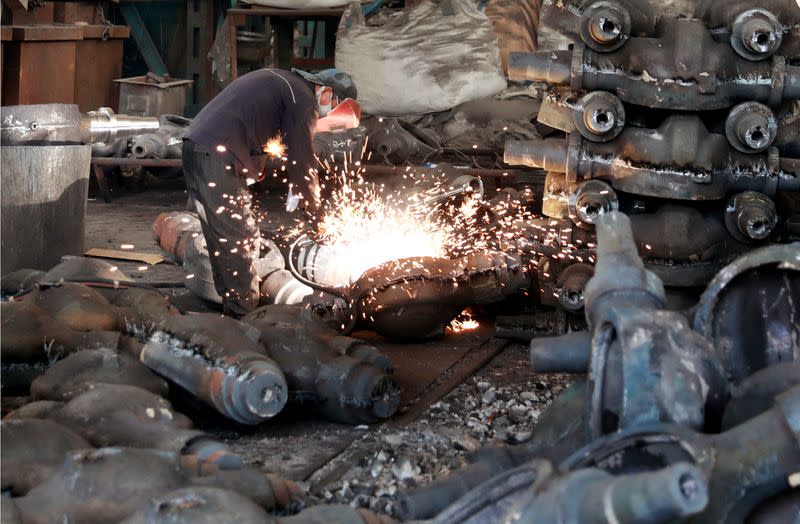July has started with mixed reports on China’s factory activity. An official survey on Sunday reported a drop in activity in June for the second month in a row, while a private survey of smaller manufacturers by Caixin/S&P on Monday was more positive.
The National Bureau of Statistics conducted broad research, which came up with a purchasing managers’ index (PMI) of 49.5 in June, the same as it found in May, but it said services activity slipped to a five-month low.
But the Caixin/S&P Global study – which covers smaller, export-oriented firms, put manufacturing PMI at 51.8 – the fastest growth since May 2021, which was well over analysts’ forecasts.
ALSO SEE: US Lawsuit Says Temu Shopping App Has ‘Hidden Spyware’ – AT
The Caixin PMI survey showed manufacturing output growth hit a two-year high in June. The orders index, including the overseas orders index, remained in expansionary territory last month, albeit at a slower rate. Demand for consumer and intermediate goods was stronger than that for investment goods, it said.
China’s exports exceeded forecasts in May, but analysts said the jury is still out on whether export sales are sustainable on top of recent trade tensions.
Recovery momentum slips
“The PMIs for June were mixed, but on balance suggest that the (economic) recovery lost some momentum last month,” Zichun Huang, China Economist at Capital Economics, wrote in a research note.
The surveys were also possibly weighed down by negative sentiment due to recent tariff announcements from the US and the European Union, Huang added. The EU is set to impose preliminary import tariffs on Chinese electric vehicles on Thursday (July 4).
Xu Tianchen, a senior economist at the Economist Intelligence Unit, said external and domestic demand remains relatively inadequate to absorb China’s manufacturing capacity and that would prevent a recovery in producer prices.
An NBS sub-index of production was above 50 in June, but other indexes on new orders, raw material stocks, employment, supplier delivery times and new export orders were all in contractionary territory.
With consumers wary and the Labour Day holiday boost fleeting, the non-manufacturing PMI, which includes services and construction, fell to 50.5 from 51.1 in May, the lowest since December.
China’s economy has struggled to find a solid footing as the country’s vast property sector, which failed to respond to a rescue package announced in May, continued to drag on people’s outlook. Prices of new homes in China climbed at their slowest pace in five months in June, a private survey showed on Monday.
The Caixin survey showed business owners are facing rising costs driven by higher prices of raw materials such as steel, copper and aluminium and rising freight costs. As a result, the input subindex rose at the fastest pace in two years.
“Insufficient market confidence and effective demand remain key challenges,” Wang Zhe, Senior Economist at Caixin Insight Group, said.
Meanwhile, manufacturing producers’ confidence for the next 12 months hit the lowest point since November 2019, due to concerns over rising competition and uncertainty about the economic outlook. The industry was still scaling back hiring in June.
Services and construction data sink
In the official NBS survey, services PMI sank to 50.2, a five-month low, and construction PMI slipped to 52.3, the weakest reading since July last year.
Analysts expect China to roll out more policy support measures in the short term, while a government pledge to boost fiscal stimulus is seen helping kick domestic consumption into a higher gear.
“The weak PMI figures naturally call for more supportive policies from the Chinese government. However, the room for monetary policy easing is limited for the time being, as the Chinese currency is under pressure,” Hao Zhou, chief economist at Guotai Junan International, said.
“That said, fiscal policy is likely to take the driving seat, suggesting that the central government will need to issue more debt over the foreseeable future to boost the overall domestic demand.”
But high local-government debt and deflationary pressure cast a long shadow over recovery prospects, despite a slew of measures officials have rolled out since last October, tempering investors’ and factory owners’ expectations.
Premier Li Qiang told a World Economic Forum meeting last Tuesday that growth of new industries was supporting healthy economic development.
But economists and investors are waiting to see what changes emerge from the Third Plenum to be held on July 15-18, when hundreds of China’s top Communist Party officials gather in Beijing for a five-yearly meeting.
- Reuters with additional editing by Jim Pollard
NOTE: This report was rejigged to incorporate news from the Caixin survey on July 1, 2024.
ALSO SEE:
China’s New Rare Earth Rules Seek Product Traceability Details
US Planning ‘Aggressive’ Rules on Data Security for Chinese EVs
Red Sea Attacks, US Tariffs on China Imports Choke Asian Ports
Toyota to Launch EV With Tesla-Like Driving System in China
European Farmers Fear Trade War With China Over EV Tariffs
China Plenum in July Aims to Modernise, Reform Economy
Carbon Removal Could Rake in $100 Billion Annually From 2030






















